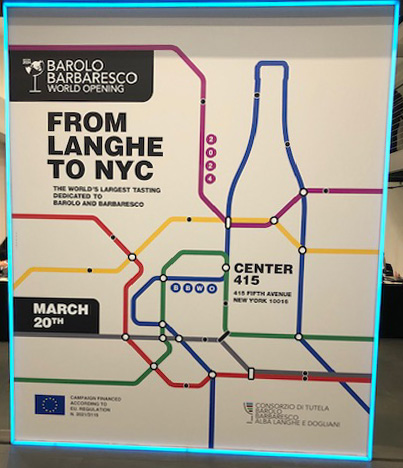A huge tasting of Barolo, Barbaresco, and Nebbiolo from the Langhe in New York represented almost 200 producers¾probably close to half the total number of producers in Barolo and Barbaresco. The focus was on recent vintages, most often 2020 (in many cases about to be released in the U.S.), with some 2019s and 2018s, and even a few 2021s. The great surprise was how approachable the wines are: there are not so many that are actually ready, but there are few that won’t be ready within the next year or so.
This could scarcely be more of a contrast with the traditional view of Barolo and Barbaresco, that the wines need at least a decade before you even begin to think about opening them. To be sure, earlier maturation is a world wide trend, but perhaps because Nebbiolo has never been focused on fruits that in principle could come to the fore to hide the tannic structure, the increase in approachability is an even greater contrast with tradition than it is, say, in Bordeaux and Burgundy.
Increased ripeness and management of tannins has narrowed the gap between Barolo and Barbaresco. Indeed, ‘fruity’ appears in my notes for wines from both appellations, something that I don’t believe has ever happened before for either Barolo or Barbaresco. Evidence of fruit may be a touch more common in Barbaresco, but the result of this lightening of style is that the difference between Barolo and Barbaresco has narrowed, to the point at which they would be difficult to distinguish in a blind tasting.
2018 is the classic lighter vintage from Barolo, very tempting for consumption in restaurants, as the result of rain during the season. There were not many examples of the vintage at this tasting, but those that were presented showed well even against 2019, which is considered a more classic year. Perhaps the 2018s are showing better than expected because few single-vineyard wines were made this year, and the grapes went into the communal wines. The 2020 vintage is perhaps a touch lighter than 2019 which (perhaps because of the extra year in bottle) seems to have a little more richness at this point. From limited samples, 2021, also referred to as a classic vintage, seems a little tighter than 2020.
There does not seem to be much correlation between the new lighter style and the aging regime, that is, whether the wine ages in large botti or in barriques. Some of the wines did show a very slight sense of spice, but it would probably be over-imaginative to put this down to new oak: in fact, I would have to say that I did not taste any wines at all where I could really detect oak directly as a flavor component. If there is a trend, it is backing away from barriques with more focus on large oak.
A few wines gave a more modern impression, by which I mean a softer, fruitier impression on the palate; a few wines went in the other direction and showed an obvious sense of structure in the form of tannic dryness. But the main impression is a consensus about style in the sense of a determined effort to make the wines more approachable sooner, if not quite immediately. Aside from the few wines at each extreme, it would be an extremely astute taster who could identify aging regimes.
At the other end of the scale, I am left wondering how many wines will really have extended longevity. My average tasting note said, start in 3 years, and drink for a decade. At a comparable tasting 20 years ago, my average note would probably have said, don’t start for 10 years and then drink for at least another 10 years. On the other hand, it is almost certainly true that the wines made in the recent vintages will be enjoyable to drink overall for just as a long a period as the wines of the past , even if that period starts much sooner. The swings and roundabouts of outrageous fortune (to misquote Hamlet and mix metaphors) is the unresolved question as to whether today’s wines, at their peak, will reach the same level of complexity as those of the past.
